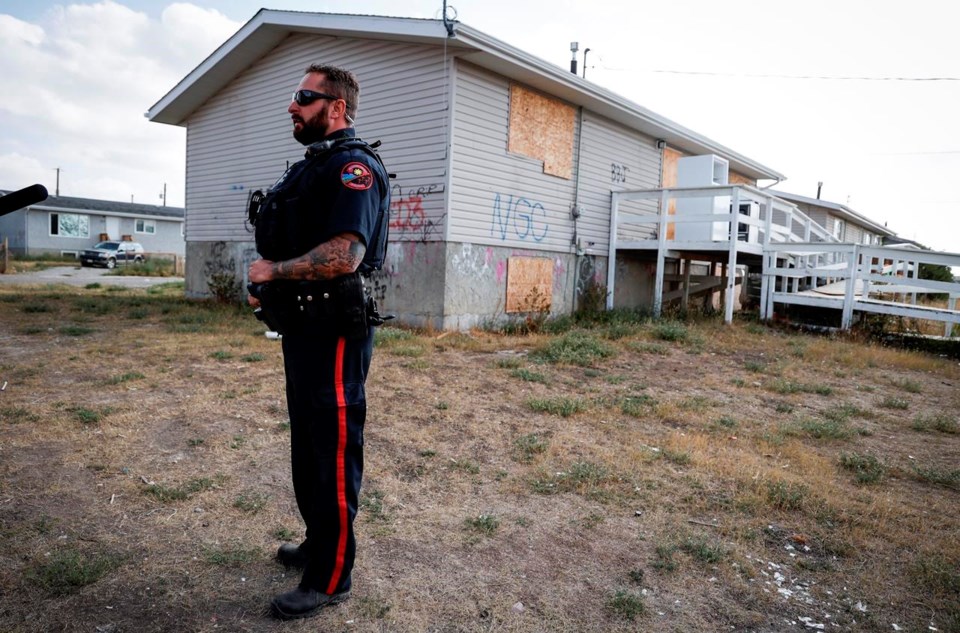STANDOFF, ALBERTA — Plywood covers the doors and windows of several homes on the Blood Reserve, a vivid image of the southern Alberta First Nation's life-and-death battle with drug traffickers.
The community 200 kilometres south of Calgary announced in April it was going to war against rampant opioid use on the reserve of 10,000 by setting up a special police team, and cleaning up and renovating many abandoned houses to shut down drug operations.
A beige bungalow in Standoff was one of the homes targeted by the drug squad. It's been cleaned out. Only a child's plastic toy space gun lay on the ground outside on a late August day.
"In this home, there were quite a few children and we did have information that fentanyl was being sold, and with fentanyl even just the dust from the product can cause health concerns," says Const. Manasse Gabor, one of three officers from the Blood Tribe Police's drug team.
"It's heartbreaking. It's one thing to commit a crime, but it's another thing to involve children and use them as a cover or a shield to an extent."
At another home 20 kilometres south in Moses Lake, a pile of garbage on the front porch included a single Nike women's running shoe, a pair of blue jeans, a black toaster and a dozen mismatched seat cushions from chairs and sofas.
The sign on the front door from Blood Tribe Housing warns against trespassing or vandalism.
The clampdown appears to be working.
"We went from about 26 overdoses a month down to five or six after several major arrests," Gabor says.
"Fentanyl is a lot less available right now. We hit it hard. It's not going to go away overnight. If you close an eye to (drug dealers)for five minutes, they're going to start again."
Canada's largest reserve has been hit hard by the opioid epidemic that has plagued many parts of the country. It started with fentanyl, an opioid up to 100 times more powerful than heroin, which is prescribed as a painkiller for terminal cancer patients.
Despite past measures, including states of emergency and banishing drug dealers, the problem appeared to be getting worse.
Blood Tribe Chief Roy Fox says desperate times required desperate measures, and that included investing $1.5 millionof the First Nation's own funds to fight the problem.
"Probably we'll never be able to do away with it completely, but we want to bring those numbers down," says Fox.
"Too many of our people have died, too many of our people are addicted to these bad drugs and we really want to key in on how we can prevent these illegal, harmful drugs from getting to the Blood Reserve."
Investigators say in several cases, drug dealers from the reserve move in with older relatives or people with young families and set up shop.
Gabor stands in front of one house that authorities boarded up recently due to drug activity.
"It was an instance of dealers coming in and taking advantage of the homeowner and children in the house who were not so well off. So they would come in and provide them with the money and the drugs that they needed in order to have a place to sell."
After police make arrests, the other people living in the homes are served with eviction notices.
"Evictions are usually handed out that same day. Then, of course, the homes are repurposed, renovated. There is a waiting list for families and other people who are needing homes, so they want to make sure that happens as quickly as possible," says Insp. Rayan Najjar with the Blood Tribe Police.
He says some of the homes had been abandoned and taken over by squatters, but the vulnerable living in others are being taken advantage of.
Fox says so far six of the homes have been renovated, but another eight are beyond repair and have to be rebuilt.
"You can't renovate some of them because of how they were contaminated by these drugs because it's within the house. It's embedded in the house," Fox says.
Gabor says school-age children to the elderly have struggled with addiction in the community.
"Those who are dealing the drugs, quite frankly, don't care about the deaths," he says.
"Money speaks, so if they can make money and people are willing to pay for it, they'll take your last $20."
This report by The Canadian Press was first published Sept. 5, 2023.
Bill Graveland, The Canadian Press



